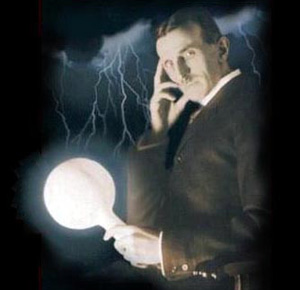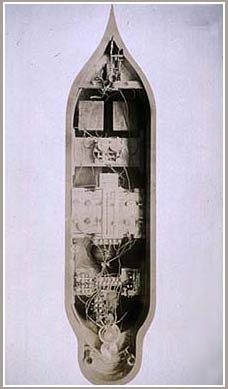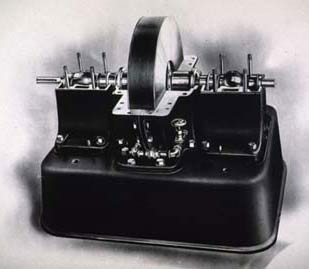Nikola Tesla: Inventor of dreams (Events Science stories)
How can romantic and romantic sunsets relate to alternating current electric motors? In dreams, anything is possible, especially the dream of a genius inventor like Nikola Tesla. And here, it is important that Tesla's dreams have given mankind the most basic and important inventions of industrial civilization.
When members of the Chicago Chamber of Commerce listened to a lecture by famous electrical inventor Nikola Tesla on May 13, 1899, they were stunned to see an artificial lake in the middle of the hall. Everyone was chattering, surely Tesla would do something very interesting with a small canoe floating on the other lake. Suddenly, the boat suddenly moved around the lake and emitted gleaming lights. On shore, Tesla operates a remote control unit, which uses invisible radio waves to transmit commands to the boat. In front of the excited crowd, Tesla invited some people to shout: "Turn left! Glow!". Using its wireless transmitter, Tesla continuously transmits signals to the boat. Even more interesting, Tesla also showed people a special fake battle screen, driving dynamite blasts into the enemy ships. At the time, Tesla was unaware that his "toy" model had become the first prototype of a guided missile - an extremely dangerous weapon.
Dream of a kind of motive
Famous electrical inventor Nikola Tesla
Famous electrical inventor Nikola Tesla (1899-1943) - (Photo: Occultopedia) Tesla was born on July 10, 1856 in a Serbian family on the border of the Austro-Hungarian empire, today Croatia. As a teenager, Tesla studied engineering at the Joanneum Polytechnic in Graz, Austria. There, the lectures on physics by Professor Jacob Poeschl attracted many young people. From Poeschl's lectures, Tesla began to think about one of his most important inventions, an AC (alternating current) motor.
One day, while observing his professor trying to overcome the phenomenon of sparking from the inverting brushes of a DC motor (direct current), Tesla came up with the idea of making a type of motor. Without needing the commutator, he immediately proposed to the master. Annoyed by his students' stubbornness, Poeschl explained a long line about the inability to build such a motor, eventually he concluded: "Mr. Tesla will probably make great things. Great, but you will never be able to do that! ". However, such a rebuke sparked in Tesla the simmering determination of youth aspirations. During his years in Graz and later in Prague, he continued to pursue the study of a non-sparking engine.
In 1881, Tesla moved to Budapest to work for the brothers Tivadar and Ferenc Puskas. As an ambitious donor, Tivadar once convinced Thomas A. Edison to give himself the inventions to introduce them on continental Europe. The Puskas brothers are planning to build a telephone station in Budapest using an innovative Edison phone design. Unfortunately, they were unable to find a worker when Tesla suddenly became seriously ill. Thanks to the interest of his classmate Anthony Szigeti, Tesla was able to recover.
It was during a walk with Szigeti that Tesla came up with an eccentric idea about his engine. While they were passionately watching the sunset, Tesla suddenly envisioned using the rotating magnetic field for the engine - it was a decisive idea. Tesla did the reverse engineering, instead of changing the magnetic pole in the rotor, he changed the magnetic field inside the stator itself. This new configuration naturally eliminated the generation of sparks. Tesla has found that if the magnetic field in the stator rotates, it will induce an electric field on the rotor and thus cause the rotor to spin. He also began to imagine that a rotating magnetic field could be created using AC instead of DC, but at the time he did not know how to turn this idea into reality.
Canal invention invention.

The boat is controlled by radio waves
Tesla spent the next 5 years testing and shaping its engine. After helping the Puskas brothers build a telephone station in Budapest, Tesla and Tivadar moved to Paris, where they were involved in setting up the city's lighting system. In 1884, Tesla went to New York to meet Edison but he did not have the opportunity to build a relationship with this brilliant inventor. In New York, Tesla was almost able to talk to Edison about the idea of his engine.
He recalls: "At that time on Coney Island, I was preparing to explain to Edison when someone ran up to drag him away. That afternoon I went home and had a fever, this time I decided I would not tell anyone about your engine. " A few months later, when Tesla had just completed the design of an innovative arc-lighting system, his manager swore to not pay the promised bonus, the inventor left in indignation.
Tesla then went to work for businessmen Benjamin A. Vail and Robert Lane from Rahway, who advised him to apply for the patent for the arc lamp system so they could commercialize it. Tesla innocently handed the patent over to these two devious people in the belief that they would put in devices to compete with Edison. However, Vail and Lane decided to spend money investing in light bulb applications. So, when Tesla's arc lights were just being used at Rahway, the two businessmen laid off him and reorganized the factory. Completely empty-handed after being abandoned, Tesla was forced to dig a canal to make a living.
Despite suffering an entire year of hardship, Tesla also gathered its talent in March 1866 to complete an application patent for the engine from heat - it's a new, powered device. on heating and cooling magnets. After presenting his invention to the canal manager, Tesla was introduced to Charles Peck, a fairly clever lawyer. Intrigued by the heat engine, Peck decided to sponsor Tesla's research. Because he was not a technical expert, Peck invited Alfred Brown, a Western Union supervisor, to provide support for Tesla.
Peck and Brown hired a lab for Tesla in Manhattan, where the inventor worked hard to develop the engine from his heat. Until he saw the inefficiency of this engine model, Peck let Tesla continue to improve the AC motor. Tesla began experimenting with a combination of alternating current used for motors. This approach proved quite unusual, because most experimenters at the time only worked with an alternating current in their system. By September 1887, Tesla had discovered that he could create a rotating magnetic field by sending two separate alternating current lines into pairs of coils placed opposite each other on the stator. Today these two currents are called 90-degree phase difference, and the motor will operate with two-phase current. Proud and excited about the achievement, Tesla has also produced some other inventions, also based on the principle of rotating magnetic field. Of particular importance, it was Tesla, who came up with the idea that multi-phase alternating current can transmit energy over significant distances.
When Tesla's AC motor clearly demonstrated its effectiveness, his sponsors began thinking about promoting it for profit. Peck and Brown plan to auction Tesla inventions, not put them into production processes. Eventually, they arranged for Tesla to do teaching before the American Institute of Electrical Engineering in 1888. The Tesla lectures published in the magazine soon attracted the attention of George Westinghouse, a who has a reputation for making air brakes and signaling systems for railroad tracks.
Tesla's Turbine
(Photo: Geocities) At that time, luminaire companies were considering switching from DC to AC, because AC could be transmitted over longer distances, reaching more customers. While Edison was still focusing on DC techniques, Westinghouse decided to bet on AC. Therefore, Peck and Brown were able to persuade him to pay a generous amount for Tesla's inventions. In July 1888, Westinghouse paid $ 75,000 in advance and $ 2.5 in royalties for each horsepower each engine was made. Tesla generously divided its two sponsors by five-ninth of the proceeds.
Westinghouse hoped Tesla's engines could be used to drive streetcars, so Tesla went to Pittsburgh to improve his design to suit this application. However, Westinghouse inventors and engineers were confused by technical difficulties. Because Tesla's motor requires two alternating current and four ends, it cannot be hooked into an existing single-phase AC system, so additional wires need to be installed. Although Tesla also developed some two-wire motors, so-called phase-dividing designs that worked best at 50Hz or lower, at the time, Westinghouse's single-phase system was using 133Hz line so that customers cannot see the incandescent light bulb flickering.
Westinghouse engineers finally solved the problem by adjusting Tesla's engine and developing a new AC system using the 60Hz three-phase current. Westinghouse demonstrated this new technology spectacularly when constructing a hydroelectric station on Niagara Falls, which transmitted electricity over a 25-mile distance to Buffalo plants. Today, Tesla's motors and multi-phase AC systems have become the basis for power supply systems in North America.
Electrical resonance
Long before the Niagara station went into operation, Tesla felt impatient and left Westinghouse. Using its royalties, in 1889 Tesla set up a new laboratory in New York City. To attract public attention, he created his image of an eccentric inventor. As well as the curiosity of Edison's inventions at Menlo Park in the 1870s, in the 1890s, people also flocked to Tesla's lab to see his strange inventions.
While seeking to create arc light using the AC system, Tesla discovered new fundamental phenomena, involving high-frequency electrical phenomena. He wondered, asking himself if it was possible to create motors with AC 60Hz, what could be built with a current of 10,000Hz? Previously, Tesla connected the chokes, resistors and capacitors together to form his phase motors, but now he connected the chokes to the capacitor in a new configuration to create high frequency line.
The inventor has pursued this research direction for the next 15 years. Tesla realized that a properly configured circuit could amplify electrical signals, enhance their frequency and voltage. Since then, he has built "giant amplifier generators" - today called Tesla coils, which can produce sparks longer than 40 meters. Tesla also realized that it was important that resonance could be applied to detect radio signals. A generator with a certain capacitor and inductor can generate signals at a certain frequency. Similarly, if the receiver has the same capacitor and inductor as the transmitter, it will also react most strongly to the frequency of the transmitter signal.
Tesla's Aircraft Plans: From the basic idea of electrical resonance, Tesla has simultaneously pursued inventions in the field of lighting, wireless signal transmission and wireless power distribution. Hoping to develop a high-performance light bulb to replace Edison's incandescent light bulb, Tesla not only created fluorescent light bulbs, but also discovered that a vacuum tube could be used to generate light. show radio waves. Although the genius inventor did not pursue this discovery, J. A. Fleming and Lee De Forest followed him to create electronic light bulbs for radio technology.
With complete circuits for receiving and transmitting radio waves, Tesla tested them with antennae that were hung on balloons suspended on the roof of his lab and on the roof of his Manhattan hotel. Unfortunately, when Tesla's promising results began to burn, Tesla's laboratory burnt down in March 1895, all the research equipment and recording system were lost. .

Global energy generation system
In the spring of 1899, Tesla closed his rebuilding laboratory in New York and set up a research center in the mountains of Pikes Peak, Colorado. There, the inventor focused on solving a problem that he believed would become the most important application of electromagnetic waves: the transmission of cordless energy to all over the world. At that time, the demand for electricity in the United States did not seem to be satisfied, although lines were everywhere. Therefore, the inventor dreamed of a telecommunications network that can both transmit electricity and information without wires.
Tesla's new dream was based on the phenomenon of electrical resonance. Like previous radio researchers, he also saw the relationship between a transmitter and a receiver as the only two elements of a closed system.
Satisfied with the belief that energy could be transmitted underground to all over the planet, Tesla returned to New York in 1900. After that, Tesla wrote a 60-page article for Century magazine with the title "The problem of increasing human energy source". And his efforts paid off in 1901, capitalist J. Pierpont Morgan invested $ 150,000 in Tesla's wireless power transmission scheme. The inventor quickly took advantage of this money, regretting the cost of equipping a new laboratory in Wardenclyffe, on the northern shore of Long Island. Although Morgan refused to provide more money and Tesla did not get the desired technical results, the inventor still built an antenna tower 57m high in Wardenclyffe. Even relationships with many donors in New York could not help Tesla secure the financial costs to complete his project, he quickly fell into a mental breakdown.
The last years of life and legacy

Tesla was in his office in New York in 1916
(Photo: cache.eb.com)
Tesla had hoped to get the money to continue his work at Wardenclyffe by shifting his creative efforts from electrical engineering to mechanical engineering. Realizing that the power pistons of power plants are being replaced by more efficient steam turbines, he began researching a model of turbine design that was completely out of order. have propellers. Like his other inventions, turbines without propellers are based on a big idea. Because the rotating magnetic field could spin the AC motor's rotor, Tesla thought that it could be used to force the viscous force of the steam to act on closely spaced thin disks that were fastened to a turbine handle. Tesla's turbine design worked at speeds in excess of 10,000 revolutions per minute but unfortunately that speed was too fast and exceeded the stamina of all thin steel discs.
Although Tesla was unable to persuade anyone to put into production of his turbine model, he also obtained a patent for an automatic speedometer based on the same principle as the turbine. -bin. For the next two dozen years, Tesla lived on royalties for his inventor of the speedometer. He has also written for popular scientific journals, in which he often mentions the future of electricity and radio. However, more and more he felt sad and depressed. He eventually became a recluse, wandering from hotel to hotel.
In 1931, to commemorate the 75th birthday of Tesla, Time magazine published on the front page a story about the inventor signaling stars with his "Tesla machine" - it was a machine. giant radio transmitter. Intrigued by the celebration, Tesla decided to hold annual press conferences on his birthday. During these meetings, Tesla repeatedly warned of the dangers of global warfare and suggested that the disaster could be avoided by developing a super weapon capable of maintaining balance. of force. He claimed that it was a beam emitting gun that could focus a large amount of energy on the aircraft, warships and the army. In 1937, while Tesla was walking around the city, he was hit by a taxi. This time, the great inventor was never able to recover, he died on January 8, 1943.
Tesla has left a rich legacy of inventions. He was known as the father of the AC motor and in 1956, the name "tesla" was given to an international unit that measures the current density of a magnetic field. His mysterious and strange predictions have made him a saint to those groups who follow unorthodox spiritual beliefs. Enthralled by Tesla's claims of uncovering the mysterious mysteries of the universe, these believers argued that powerful figures like Edison and Morgan had conspired to prevent Tesla from perfecting inventions. and his career revolutionized the world.
Although hype and rumors are baseless, Tesla is truly a man of great contribution to science and technology. His ability to focus on fundamentals is his greatest strength, but it is also his greatest weakness. Tesla was so fascinated by the beauty of basic concepts that he could not stop pursuing every detail to perfect his inventions.
FIDITOUR TRAVEL COMMUNICATION COMPANY
Representative: Mr. Tran Van Long - Chairman and General Director
Head office: 95B-97-99 Tran Hung Dao, District 1, City. Ho Chi Minh.
Hanoi Branch: 66 Tran Hung Dao, Hoan Kiem District, Hanoi
Phone: 028 730 56789 | Hotline: 19001177